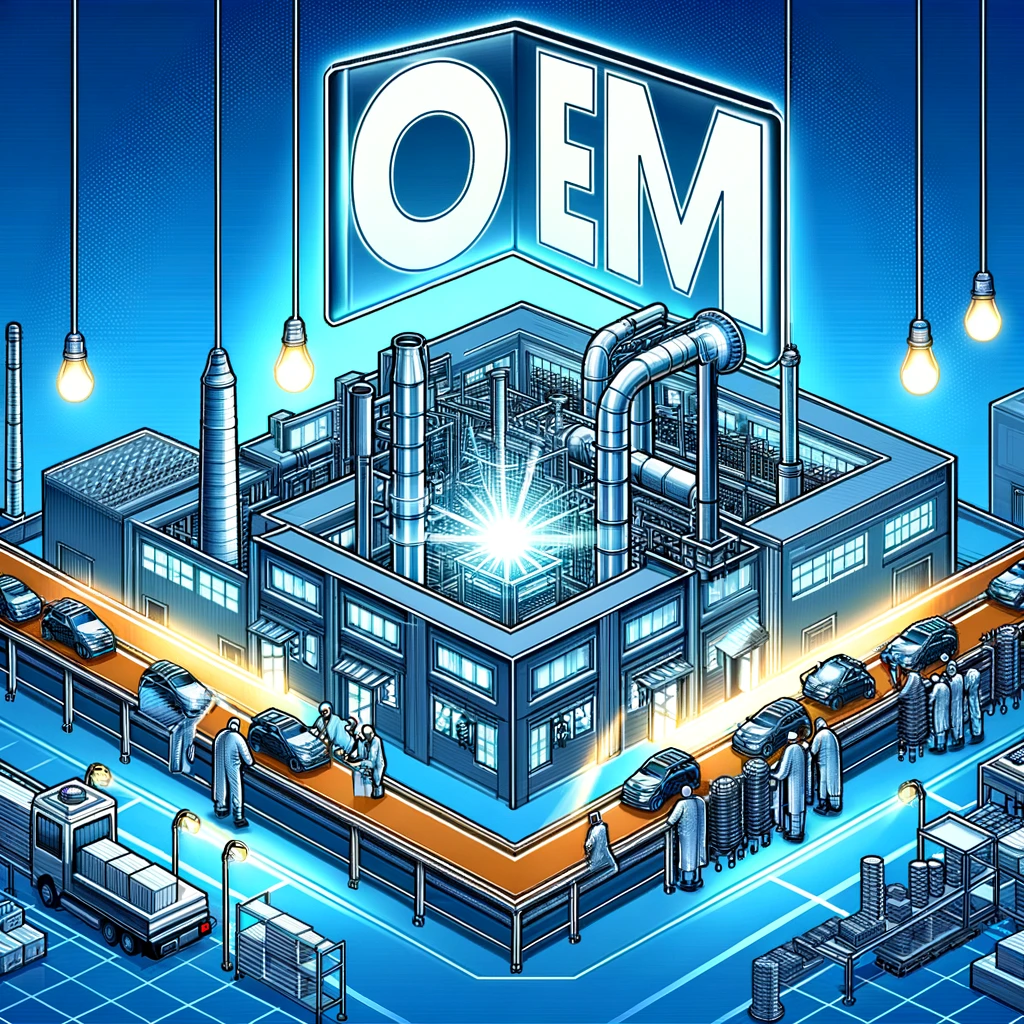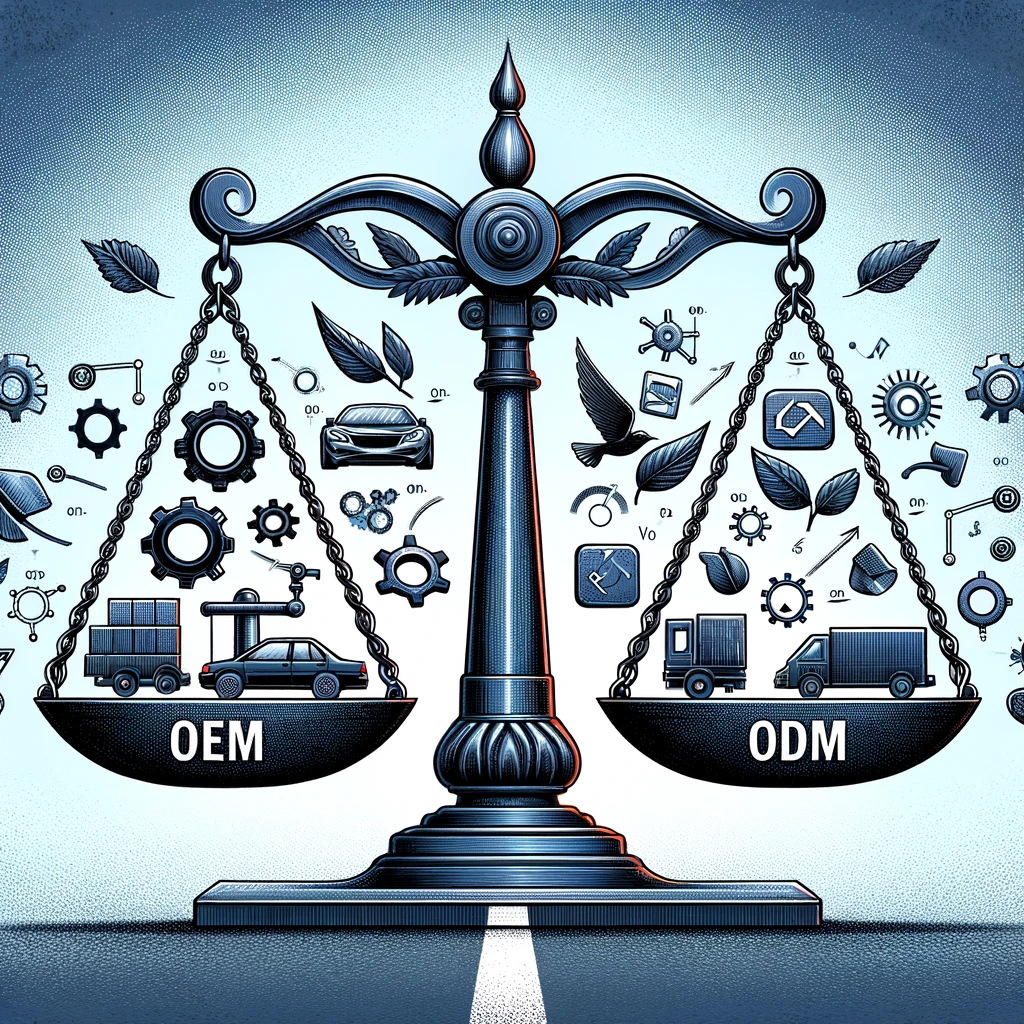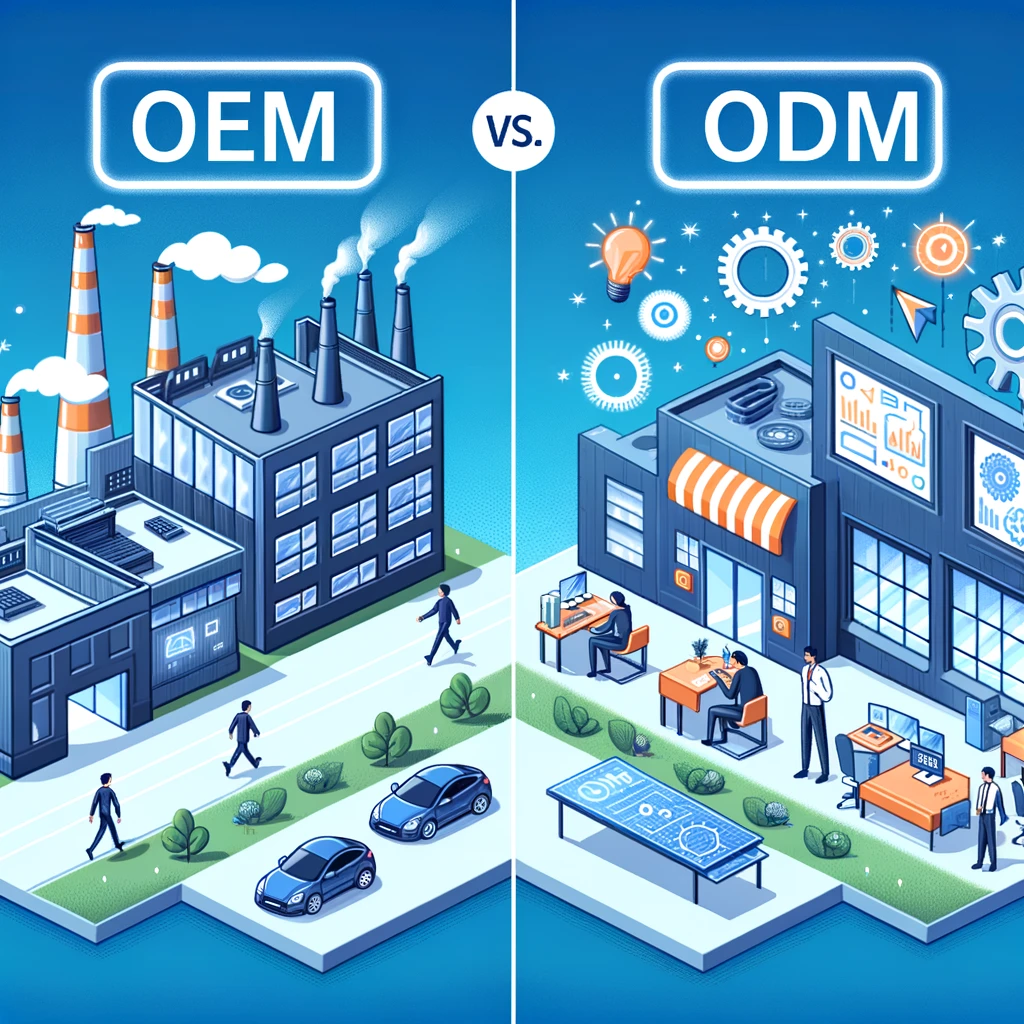Introduction to OEM and ODM in the Manufacturing Industry
Unveiling the Definitions: OEM and ODM
Are you looking to navigate the intricate world of manufacturing? Understanding the pivotal roles of OEM (Original Equipment Manufacturing) and ODM (Original Design Manufacturing) is your first step towards mastering the industry’s dynamics. OEM refers to a process where companies produce parts or products that are then branded and sold by another company. On the other hand, ODM involves manufacturers designing and producing goods that other companies sell under their own brand name. Both these models are fundamental, yet they cater to distinctly different business needs and strategies.
The Global Impact of OEM and ODM on Manufacturing
The influence of OEM and ODM in the manufacturing sector is undeniably profound. These frameworks are not just production methods; they represent strategic pathways that companies traverse to leverage cost-efficiency, innovation, and market penetration. For instance, a report from the International Trade Administration highlighted that OEM and ODM models, particularly in the technology sector, have significantly contributed to the exponential growth of consumer electronics on a global scale. The versatility and adaptability of these models empower companies to meet diverse consumer demands swiftly and efficiently. In a world where time-to-market and innovation are the linchpins of success, OEM and ODM stand out as the twin pillars supporting the vast and varied edifice of global manufacturing.
OEM (Original Equipment Manufacturing) Uncovered

Understanding OEM: Definition and Core Characteristics
Ever wondered how the biggest brands maintain product consistency across the globe? The answer often lies in Original Equipment Manufacturing (OEM), a cornerstone in the global manufacturing landscape. OEM is a practice where products or components are manufactured by a third-party company but sold under the brand name of the purchasing company. This model is paramount for brands focusing on quality control, cost reduction, and brand consistency. For instance, many leading computer manufacturers rely on OEM partnerships to produce consistent, high-quality components, ensuring that the end consumer receives a product that meets stringent brand standards.
Navigating the OEM Process: A Step-by-Step Guide
Understanding the OEM process is essential for any business looking to harness its full potential. The journey begins with a detailed product specification provided by the brand to the manufacturer, ensuring that the end product aligns with the brand’s quality and performance standards. This is followed by a phase of meticulous production, where the manufacturer’s expertise in efficient production techniques comes into play. Regular quality checks and communication between the brand and the manufacturer are crucial throughout this process, culminating in the delivery of a product that resonates with the brand’s vision and market expectations.
Weighing the Pros and Cons of OEM in Global Manufacturing
While OEM offers numerous advantages, such as cost efficiency, scalability, and access to specialized manufacturing capabilities, it also comes with its set of challenges. Brands might face issues related to intellectual property rights, less control over the manufacturing process, and potential quality inconsistencies if not managed properly. For example, a study from the Harvard Business Review highlighted that companies engaging in OEM must invest in robust partnership management and quality assurance protocols to mitigate these risks and capitalize on the OEM model’s inherent benefits.
Strategic Integration of OEM in Supply Chain Management
Integrating OEM into your supply chain requires strategic planning and a keen understanding of your market. Successful OEM integration often involves aligning your product development cycles with your OEM partner’s manufacturing capabilities, ensuring timely market entry. Furthermore, maintaining a transparent and collaborative relationship with your OEM partner can lead to continuous improvement in product quality and innovation. For instance, companies like Apple have mastered OEM integration, ensuring that their products consistently meet high standards of innovation and quality, thereby maintaining their market-leading position.
ODM (Original Design Manufacturing) Explained

Defining ODM: What Sets It Apart?
Do you know how some brands consistently deliver market-redefining products? The secret often lies in Original Design Manufacturing (ODM). Unlike OEM, ODM allows brands to avail of products that are not only manufactured but also designed and developed by the manufacturing company. This model is pivotal for brands aiming for innovation, speed to market, and product differentiation. ODM is particularly beneficial for companies that lack in-house design capabilities but wish to expand their product portfolio with unique offerings. For instance, many consumer electronics companies leverage ODM partnerships to introduce cutting-edge products without the overheads of extensive R&D departments.
The Comprehensive ODM Process: From Concept to Market
The ODM process embodies a journey from a nascent product idea to a market-ready offering. It starts with the manufacturer’s in-house R&D team crafting a product concept that aligns with market trends and client requirements. Following this, the product undergoes rigorous development and testing, ensuring it meets quality standards and market needs. The process is marked by a collaborative approach, with continuous feedback loops between the brand and the manufacturer, leading to a refined, market-competitive final product.
The Advantages and Challenges of ODM
Opting for ODM brings a plethora of advantages, including reduced time and cost associated with product development, access to specialized expertise, and the ability to introduce innovative products swiftly. However, brands must navigate certain challenges like reduced control over the product design, potential market saturation due to similar products, and the need for strong partnership management. A report by McKinsey & Company emphasized that successful ODM partnerships require a strategic alignment of goals, transparent communication, and a shared commitment to product excellence.
Enhancing Market Responsiveness with ODM Strategies
Incorporating ODM into your product strategy can significantly enhance your market responsiveness. It allows brands to quickly adapt to changing consumer preferences and emerging market trends. To fully leverage ODM, brands should focus on establishing clear communication channels, setting well-defined product requirements, and building a collaborative relationship with their ODM partner. This strategic approach enables brands to not only expedite product development cycles but also ensures the delivery of high-quality, innovative products that resonate with consumers.
OEM vs. ODM: A Comparative Analysis

Intellectual Property in OEM and ODM: Protecting Your Innovations
Have you ever pondered the importance of intellectual property in manufacturing? When it comes to OEM and ODM, intellectual property (IP) is a critical facet that can significantly influence your business strategy. In OEM, the buying company often provides the specifications and retains the IP rights, ensuring brand uniqueness. Conversely, with ODM, the manufacturer holds the IP rights as they design the product, posing potential challenges in exclusivity and brand differentiation. A comprehensive understanding and strategic management of IP are paramount in safeguarding your innovations and maintaining your competitive edge in the market.
Analyzing Cost Implications: OEM vs. ODM
Cost is a decisive factor in choosing between OEM and ODM. Generally, OEM can be cost-efficient for large-scale production as it involves manufacturing products to detailed specifications, often resulting in economies of scale. However, ODM can be more cost-effective for smaller batches, offering lower development costs and shorter timeframes for product introduction. The key is to conduct a thorough cost-benefit analysis, considering all factors such as production volume, market demand, and long-term strategic goals to determine the most financially viable option.
Quality Control in OEM and ODM: Ensuring Product Excellence
Quality control is the linchpin of customer satisfaction and brand reputation, irrespective of whether you choose OEM or ODM. In OEM arrangements, companies have significant control over the manufacturing process, often involving stringent quality checks to align with their standards. In contrast, ODM requires a robust trust and verification mechanism as the manufacturing company designs and produces the product, making clear communication and regular quality assessments crucial. Implementing comprehensive quality control protocols is essential to ensure that the final product meets the desired standards of excellence.
Evaluating Lead Time and Scalability: OEM vs. ODM
The agility of responding to market demands depends heavily on the lead time and scalability of your manufacturing process. OEM typically involves longer lead times due to the custom nature of production but offers greater scalability for large orders. ODM can significantly reduce lead time, allowing for quicker market entry, which is particularly beneficial in industries with rapid innovation cycles. However, it may face limitations in scalability due to the manufacturer’s design and production capacities. Balancing these aspects is crucial in aligning your manufacturing strategy with market dynamics and growth objectives.
Making the Right Choice: OEM or ODM?

Critical Factors to Consider in the OEM vs. ODM Decision
How do you decide whether OEM or ODM is right for your business? The decision hinges on several critical factors. First, consider your company’s core competencies: Do you excel in innovation and design, or does your strength lie in branding and marketing? If it’s the former, ODM might be your path. If it’s the latter, OEM could be more suitable. Next, assess your resource allocation: ODM can be resource-efficient, eliminating the need for extensive R&D, while OEM might necessitate a significant investment in design but offers more control over production. Finally, reflect on your market positioning and brand vision: OEM allows for unique product offerings that can strengthen brand identity, whereas ODM offers speed to market with ready-designed products.
Industry-Specific Insights: When to Choose OEM or ODM
The decision between OEM and ODM also varies greatly depending on your industry. In sectors like electronics or automotive, where products are complex and technological advancement is rapid, OEM allows for greater customization and brand distinction. Conversely, in the fashion or consumer goods industries, where trends are fleeting and time-to-market is crucial, ODM provides the agility to quickly capitalize on market trends. For example, a study in the fashion industry revealed that brands leveraging ODM were able to reduce their product development cycle by up to 50%, enabling them to respond swiftly to changing fashion trends.
Real-World Success: Case Studies of OEM and ODM Projects
Analyzing real-world case studies can provide valuable insights into the successful application of OEM and ODM models. Take, for instance, a leading smartphone brand that utilized OEM to maintain its reputation for quality and innovation, ensuring every component met its exact specifications. On the flip side, a renowned clothing retailer embraced ODM to quickly adapt to fashion trends, sourcing ready-to-market designs that aligned with its brand identity. These cases exemplify how OEM and ODM, when chosen in alignment with a company’s strategic objectives and market conditions, can drive success and market dominance.
The Role of Freight Forwarders in OEM and ODM

The Value Addition of Freight Forwarders in OEM and ODM Projects
Ever wondered how your products seamlessly travel from factory to market? The answer often lies with freight forwarders, the unsung heroes in the OEM and ODM processes. These specialists add significant value by ensuring efficient, reliable, and cost-effective transportation of goods. In the context of OEM and ODM, freight forwarders play a pivotal role in navigating complex global logistics, managing customs clearance, and ensuring timely delivery. Their expertise is particularly crucial when it comes to handling the intricate supply chain requirements of OEM and ODM, ensuring that components and final products are delivered in pristine condition, adhering to the set timelines and quality standards.
Mastering Logistics and Supply Chain Optimization
In the realm of OEM and ODM, the importance of logistics and supply chain optimization cannot be overstated. Freight forwarders are instrumental in designing and implementing efficient supply chain models that align with your production schedules, whether it’s ensuring the just-in-time delivery of components for OEM or the streamlined distribution of finished products for ODM. Their ability to anticipate and mitigate risks, coupled with their in-depth knowledge of global trade regulations, ensures that your supply chain is both resilient and compliant, turning potential obstacles into smooth transitions.
Custom Solutions for Enhancing OEM and ODM Operations
Freight forwarders excel in crafting custom solutions that cater to the unique demands of OEM and ODM operations. They understand that each project has its own set of challenges and requirements, from specific packaging needs to temperature-controlled transportation or high-value cargo security. By providing tailored services, freight forwarders ensure that your products, whether they are raw materials, components, or finished goods, are handled with the utmost care and expertise, enhancing the overall efficiency and reliability of your OEM and ODM projects.
The Strategic Importance of OEM and ODM in Modern Manufacturing
In today’s fast-paced and highly competitive business landscape, the strategic significance of OEM (Original Equipment Manufacturing) and ODM (Original Design Manufacturing) cannot be overstated. These models are not just manufacturing pathways but are pivotal strategies that companies adopt to carve their niche, innovate, and excel in the global market. OEM offers the advantage of brand consistency and quality control, essential for companies aiming to solidify their market presence through distinctive products. On the other hand, ODM stands as a beacon of innovation and agility, perfect for businesses looking to rapidly respond to evolving market trends without the heavy investments in research and development.
As the manufacturing industry continues to evolve, the choice between OEM and ODM will increasingly hinge on a complex interplay of factors including cost efficiency, time to market, quality control, and brand strategy. However, one thing remains clear: businesses that can skillfully navigate the intricacies of these models, adapting them to their unique vision and market dynamics, will be the ones to thrive in the future landscape of global manufacturing.
Addressing Your Top Queries on OEM and ODM in the Manufacturing Industry
What are the primary benefits of choosing OEM for my business?
OEM is beneficial for businesses seeking strict quality control, brand consistency, and product uniqueness. It allows companies to produce items that meet specific requirements and standards, ensuring the end products align perfectly with the brand's vision and customer expectations.
How does ODM promote innovation and market responsiveness?
ODM is ideal for businesses aiming for rapid market entry with innovative products. It eliminates the need for extensive in-house research and development, allowing companies to leverage the design expertise and manufacturing capabilities of ODM partners. This model is particularly effective in industries where keeping pace with consumer trends and preferences is crucial.
Are there any risks associated with OEM and ODM that I should be aware of?
While OEM and ODM offer numerous advantages, they also come with their own set of risks. In OEM, challenges include managing complex supply chains and ensuring product quality across various production sites. In ODM, risks involve potential issues with product differentiation and intellectual property rights, as the design and manufacturing are handled by external partners.
How do freight forwarders add value to OEM and ODM processes?
Freight forwarders specialize in navigating the complexities of global logistics, offering tailored solutions that ensure efficient and reliable transportation of goods. Their expertise in customs clearance, risk management, and supply chain optimization is invaluable in enhancing the operational efficiency of both OEM and ODM projects.
Can OEM and ODM be combined or customized to fit specific business needs?
Absolutely. Many businesses adopt a hybrid approach, customizing aspects of OEM and ODM to align with their strategic goals, operational requirements, and market conditions. This flexible approach allows companies to leverage the strengths of both models, ensuring a competitive edge in product development, production, and distribution.
What factors should I consider when choosing between OEM and ODM for my product line?
When deciding between OEM and ODM, consider factors such as your company's core competencies (e.g., design vs. marketing), control over the production process, time to market, budget constraints, and long-term strategic goals. It's also crucial to evaluate your capacity to manage quality control and your need for product customization versus speed and innovation.
How does the choice between OEM and ODM impact my brand identity?
OEM allows for greater control over the end product, which can strengthen your brand identity by ensuring that every item aligns with your brand's quality standards and aesthetic. Conversely, ODM can offer quicker access to market trends, but it might require more effort to differentiate your products from competitors, as the design is not exclusive to your brand.
In what ways do technological advancements influence OEM and ODM strategies?
Technological advancements, particularly in areas like automation, AI, and data analytics, are transforming OEM and ODM strategies by enhancing production efficiency, enabling more precise market analysis, and facilitating better communication and collaboration between partners. Companies that effectively integrate these technologies can gain significant competitive advantages in product quality, innovation, and time to market.
How can I ensure the protection of my intellectual property when engaging in ODM?
To protect your intellectual property in an ODM arrangement, it's crucial to establish clear contracts outlining IP ownership, conduct thorough due diligence on potential partners, and possibly register your IP in the countries where your products are being designed and manufactured. Regular monitoring and legal readiness to enforce your IP rights are also important.
Are there specific industries or sectors where OEM or ODM is more prevalent?
Certain industries have a stronger prevalence of OEM or ODM based on the nature of the products and market dynamics. For instance, OEM is prevalent in the automotive and electronics sectors due to the need for precise specifications and quality. ODM is more common in industries like fashion and consumer goods, where speed and responsiveness to market trends are critical.












